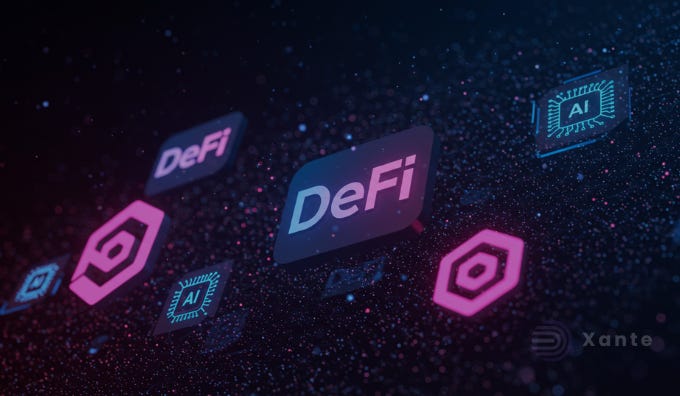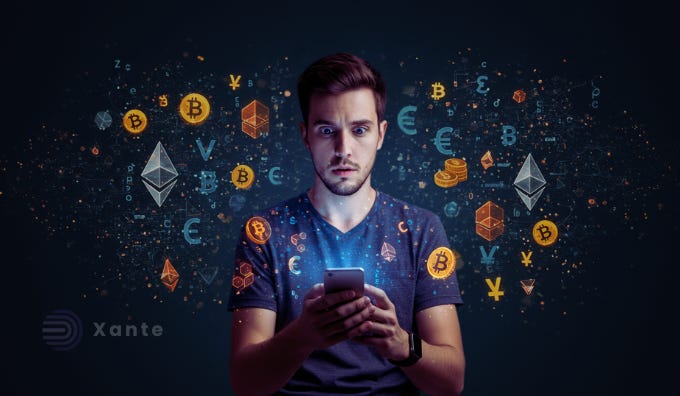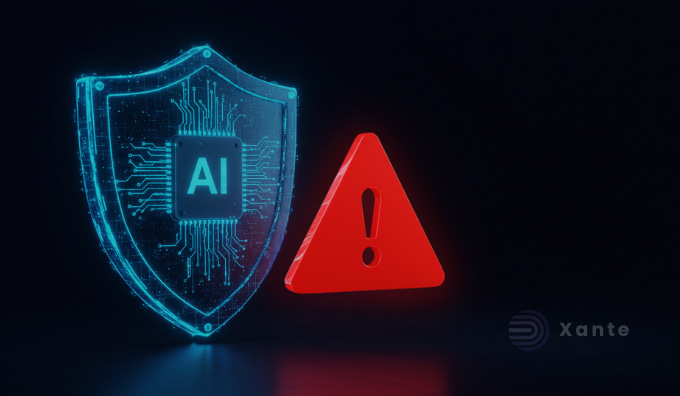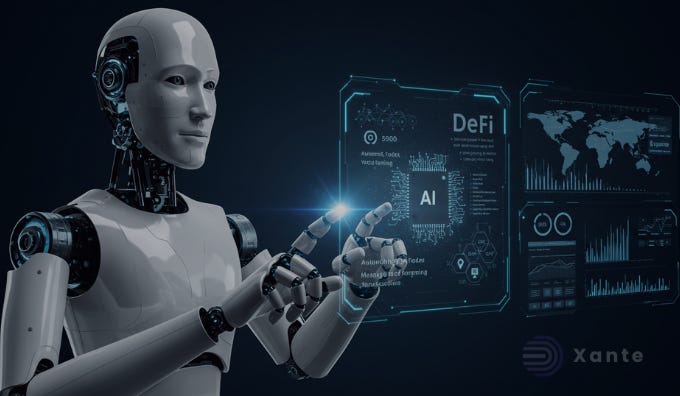DeFi Just Got Smarter: How AI is Changing the Game for Crypto Users
DeFi Just Got Smarter: How AI is Changing the Game for Crypto Users
Navigating DeFi is complex, but AI-powered tools like DeFAI are making it easier. Learn how AI is simplifying trading, reducing risks, and making DeFi more accessible.
Is DeFi Still Too Complicated? AI Has a Solution
Ever tried using DeFi and felt like you needed a PhD in blockchain just to make a simple transaction? You’re not alone. With gas fees, liquidity pools, and bridging complexities, even experienced crypto users can get lost in the weeds.
But what if executing DeFi transactions was as simple as typing a sentence? What if AI could handle the complexities for you, securing transactions, optimizing yields, and protecting your funds?
That’s exactly what AI-powered DeFi tools like DeFAI are doing. They’re transforming the way users interact with decentralized finance, making it smoother, safer, and more accessible.
This week’s crypto roundup dives deep into how AI is reshaping DeFi, making it easier to use, protecting users from costly mistakes, and paving the way for a more inclusive financial future.
The Problem: Why DeFi Feels Like a Maze
1. Overwhelming Jargon and Technical Barriers
DeFi is full of complex terms like staking, slippage, impermanent loss, automated market makers (AMMs), and tokenomics.
Imagine you’re a newcomer looking to lend USDC on AAVE. Before you can even get started, you need to:
• Buy USDC on a centralized exchange.
• Bridge it to a compatible blockchain (like Arbitrum).
• Pay gas fees in the correct native token (ETH, MATIC, or BNB).
• Navigate AAVE’s interface and select the right lending pool.
Each step requires technical knowledge, creating a high barrier to entry for everyday users.
Real-Life Example
John, a first-time DeFi user, wanted to stake his tokens for passive income. But after spending two hours watching YouTube tutorials, he gave up, afraid of making a costly mistake.
This is why many users stick to centralized exchanges like Binance, which are easier but sacrifice decentralization.
2. High Risk of Scams and Human Error
Unlike traditional finance, DeFi has no customer support or fraud protection. If you send funds to the wrong wallet or approve a malicious contract, your assets are likely gone forever.
Common DeFi Risks:
• Phishing scams: Fake support agents trick users into revealing seed phrases.
• Clipper malware: Hackers replace copied wallet addresses with their own.
• Smart contract exploits: Flaws in DeFi protocols allow hackers to drain funds.
Real-Life Example
In 2023, an investor accidentally sent $1 million USDT to the wrong wallet address, a mistake that couldn’t be reversed. AI-powered tools aim to prevent these disasters.
The Solution: How AI is Making DeFi Easier and Safer
1. AI-Powered Abstraction: Say Goodbye to Manual Processes
DeFAI automates complex DeFi actions, allowing users to execute transactions using natural language.
Instead of manually bridging tokens and calculating slippage, users can simply type:
“Stake 100 USDC in the highest-yield pool.”
The AI handles:
• Finding the best protocol.
• Bridging assets to the right network.
• Paying gas fees efficiently.
• Confirming security parameters.
Example in Action
A trader using Griffain AI, an advanced abstraction AI platform built on Solana that simplifies DeFi interactions by enabling users to trade, mint NFTs, manage wallets, and automate transactions using natural language commands. It can:
• Execute cross-chain swaps with a single click.
• Mint NFTs using a simple command.
• Manage their DeFi wallet without needing private key inputs.
2. AI Enhances Security by Reducing Human Mistakes
DeFAI acts as a built-in security assistant, preventing common errors like:
• Sending tokens to the wrong address.
• Approving risky smart contracts.
• Falling for phishing attacks.
How It Works
• Address Validation: AI cross-checks wallet addresses before sending funds.
• Transaction Simulations: AI predicts gas fees and slippage before a transaction executes.
• Scam Detection: AI flags suspicious interactions with blacklisted smart contracts.
Example in Action
A user tries to send funds, but DeFAI detects a scam address and blocks the transaction, saving them thousands of dollars.
3. Smarter DeFi Decisions with AI-Driven Insights
AI doesn’t just simplify DeFi, it also helps users make smarter investment decisions by analyzing on-chain and off-chain data.
For example, Anon AI; an advanced DeFi automation tool that enables seamless trading, cross-chain bridging, and real-time market analysis, helping users make smarter investment decisions with minimal effort and it provides real-time insights on:
• Total Value Locked (TVL) in DeFi protocols.
• Market sentiment from X (Twitter) and Telegram.
• Yield optimization strategies based on live market trends.
Example in Action
A trader wants to farm yield but is unsure which liquidity pool is the most profitable. Instead of manually checking multiple protocols, AI suggests the best pool based on real-time analytics.
Key Takeaways
• DeFi is still difficult for many users due to jargon, complex steps, and security risks.
• AI-powered tools like DeFAI simplify DeFi transactions by automating bridging, swapping, and staking.
• AI improves security by preventing human errors like wrong addresses and phishing scams.
• AI-driven insights help traders optimize strategies and maximize returns.
Future Outlook: AI-Powered DeFi in 2025 and Beyond
The convergence of Decentralized Finance (DeFi) and Artificial Intelligence (AI) is poised to revolutionize the financial landscape. As we look toward 2025 and beyond, several key developments are anticipated:
1. Natural Language DeFi Assistants
Advancements in AI are expected to lead to the creation of more sophisticated natural language DeFi assistants. These tools will enable users to interact with blockchain platforms using conversational language, similar to engaging with AI models like ChatGPT. This evolution aims to make DeFi more accessible to individuals without technical expertise.
2. AI-Driven Portfolio Management Systems
AI is expected to play a pivotal role in portfolio management within DeFi. AI-driven systems could automate investment strategies based on real-time market conditions, optimizing returns and managing risks more effectively than traditional methods.
rThe future of DeFi is likely to embrace omnichain solutions, where liquidity is sourced from multiple blockchains and centralized sources. This integration aims to provide better pricing and deeper liquidity, addressing challenges like liquidity fragmentation and enhancing capital efficiency.
4. Autonomous Digital Economies
AI agents are projected to transition from passive tools to autonomous network participants. Equipped with their own wallets and signing keys, these AI agents could revolutionize industries by operating and verifying nodes in decentralized physical infrastructure networks (DePIN).
5. Decentralized AI (DeAI) Infrastructure
The first half of 2025 is expected to witness a focus on building infrastructure for decentralized AI (DeAI). This development aims to support autonomous agents, enhancing decision-making processes and reducing noise in data analysis.
6. Integration of AI in Fintech
AI is anticipated to drive significant trends in fintech by 2025, including AI-powered wealth management and green fintech solutions. These innovations are set to reshape how individuals and institutions interact with financial services, promoting efficiency and sustainability.
According to industry estimates, AI-powered DeFi solutions could onboard millions of new users by 2026, breaking down technical barriers and making decentralized finance truly mainstream.
Final Thoughts: The Future of DeFi is AI-Driven
DeFi has always been promising, but its complexity has kept many from fully embracing it. AI is now changing that.
With AI-powered assistants like DeFAI, anyone can participate in DeFi without needing expert knowledge. The potential is limitless, from automated trades and secure transactions to smarter investments.
Are you ready for the AI-powered DeFi revolution? Start exploring AI-driven DeFi platforms today and take advantage of the smarter, safer future of decentralized finance.
Traditional DeFi vs. AI-Powered DeFi: A Side-by-Side Comparison
Ease of Use
Traditional DeFi: Requires technical knowledge, manual steps for bridging, swapping, and staking.
AI-Powered DeFi: Simple, one-click transactions using natural language commands.
Security
Traditional DeFi: High risk of human errors (wrong addresses, phishing scams, and contract approvals).
AI-Powered DeFi: AI prevents errors with address validation, scam detection, and transaction simulations.
Decision-Making
Traditional DeFi: Users must manually analyze charts, on-chain data, and social sentiment.
AI-Powered DeFi: AI aggregates and analyzes real-time data for better investment decisions.
Transaction Speed
Traditional DeFi: Multiple steps and confirmations slow down transactions.
AI-Powered DeFi: Automated processes make transactions faster and more efficient.
Gas Fee Optimization
Traditional DeFi: Users must manually calculate and adjust gas fees.
AI-Powered DeFi: AI predicts optimal gas fees and executes transactions accordingly.
Scalability
Traditional DeFi: Complex interfaces limit accessibility to experienced users.
AI-Powered DeFi: AI lowers the barrier, making DeFi accessible to a broader audience.
Risk Management
Traditional DeFi: Users rely on personal research and experience to avoid risks.
AI-Powered DeFi: AI-powered monitoring flags security threats and market risks in real time.
User experience
Traditional DeFi: Complicated UI with multiple tabs and settings.
AI-Powered DeFi: Seamless, intuitive interface for effortless DeFi interactions.
Explore the XanteApp today for real-time insights and stay ahead of market shifts.
Join the XanteApp Community on WhatsApp to get the latest insights on DeFi. Web3, and blockchain opportunities. Do not forget to subscribe to our newsletter for expert analysis straight to your inbox! Click here to join now.






